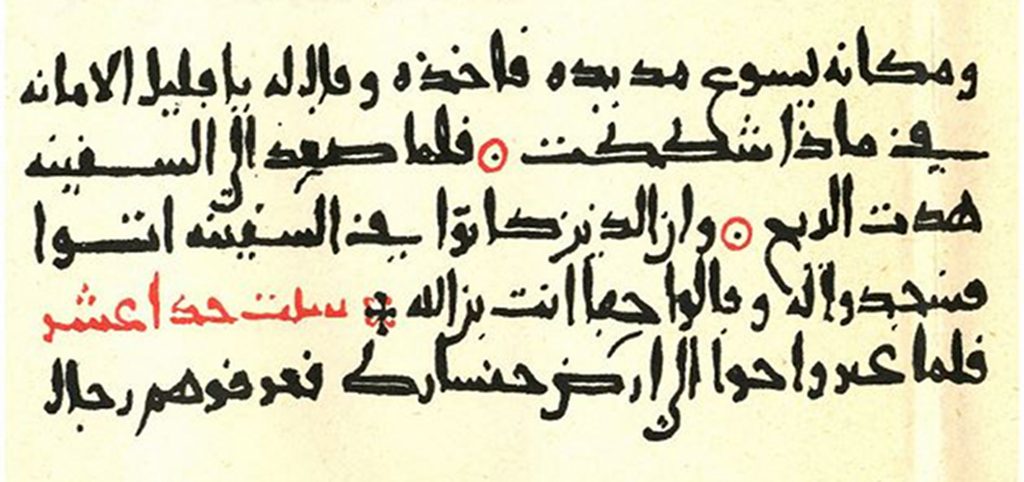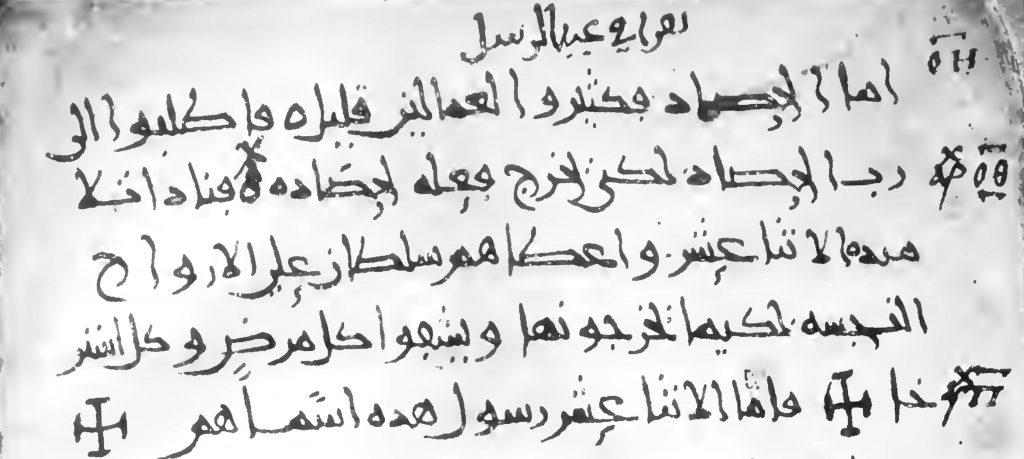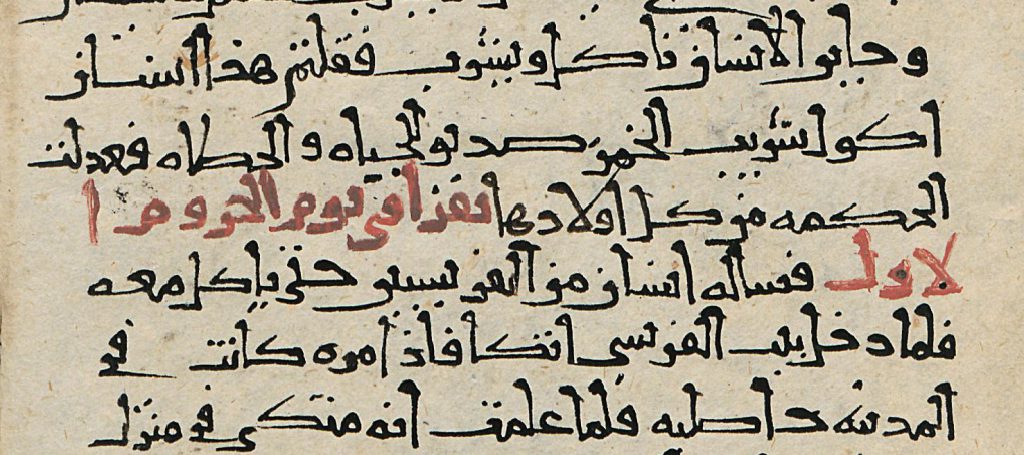Were there Arabic translations of the Bible before Islam? In the early 1930s, Anton Baumstark outlined an argument which he believed ‘mathematically proved’ that such translations existed.[1] His thesis was that the lectionary headings in some Arabic manuscripts of the Gospels were out of date after the Islamic conquests and so must have been translated beforehand. His analysis was based on three manuscripts that had found their way to Europe.

One was just a two-leaf parchment fragment, Leipzig Vollers 1059a (fig. 1), dated to the 9th century.[3] It would have been the outer bifolio of a quire containing two sections of Matthew’s Gospel. Constantine Tischendorf had taken it from St. Catherine’s Monastery on his second visit to Sinai in 1853. This fragment remained at the Leipzig University Library for many years but was reported as missing in 1938.[4] Lamentably, if Tischendorf had left it in the hands of the monks of St. Catherine’s then in all likelihood it would still be available today.[5] The fragment has rubricated headings which specify when the following passage is to be read.

Baumstark’s second manuscript, Vatican Borg. ar. 95 (fig. 2), was also dated to the 9th century. It has the same main text as the Tischendorf fragment, but it does not contain the lectionary headings except for occasional liturgical indications, added by a later hand.[7] In the place of the rubrics are empty spaces, indicating that the original scribe was aware of the location of the lectionary headings.

A third manuscript, Berlin Ms. or. oct. 1108 (fig. 3), was brought back from the East by Paul Kahle, Baumstark’s colleague at Bonn University, and deposited at the Staatsbibliothek in Berlin. Though it was much younger (dated to 1047 CE), it contained the lectionary rubrics like the Tischendorf fragment.[9] The first part of the manuscript (Mt 1:1–6:18a) is missing. It was the liturgical headings in this manuscript that were the focus of Baumstark’s argument.
A Missing Sunday
Baumstark recognized that these headings followed the old Jerusalemite lectionary calendar before it was conformed to the liturgical system of Constantinople. What was significant for his argument was that he thought that the manuscripts showed no knowledge of the Sunday before Cheesefare week. Cheesefare week is a preparatory week of fasting immediately before Lent where Christians abstain from meat, yet animal products (such as cheese) are still permitted (unlike in Lent proper). Baumstark followed the opinion of Alfred Rahlfs that this week of preparatory fasting was introduced under Heraclius after his victorious campaign over Persia (622–629 CE).[10] Since the Arabic Gospel headings seem to not accommodate Cheesefare week, Baumstark concludes that they reflect a time before Heraclius initiated the practice and thus before the Islamic conquest.
More Manuscripts
Since Baumstark’s study, a number of other Arabic Gospel manuscripts have been discovered to also contain the old Jerusalemite lectionary headings, including what is probably much of the rest of the codex of Tischendorf’s fragment.[11] Therefore, I chose to edit all the lectionary headings from all 15 known Arabic Gospel manuscripts with the old Jerusalemite lectionary. As I collated the headings, I identified nine distinct lectionary systems. These lectionary systems will be described with the edition of the rubrics in a future publication, but for now, what can we say about Baumstark’s argument for a pre-Islamic Arabic Gospel? When all the manuscripts are considered, it appears that all of the lectionary systems include readings for the Sunday before Cheesefare week at Lk 7:36. In the Berlin manuscript used by Baumstark the heading (see fig. 3 above) states that this passage is ‘Read on the first Sunday of the prohibitions’ (تقرا في حد الحروم الاول). Baumstark misunderstood this as referring to the first Sunday of Lent instead of the Sunday before Cheesefare Week.[12] He misinterpreted the word translated as ‘prohibitions’ (al-ḥurūm) as ‘anathemas’ which he understood as referring to the Feast of the Triumph of Orthodoxy initiated in Constantinople in 843 CE during which anathemas are declared against iconoclasm.[13] This would be the incorrect week in Lent for the Feast of Orthodoxy and it is strange to enumerate such a feast the ‘first’ because it is a feast of only one day but Baumstark saw this as a clumsy redaction from an original heading which he conjectured would have read ‘the first Sunday of Lent’ with the word for ‘anathemas’ later substituted for ‘Lent’. This interpretation was only possible because Baumstark’s manuscripts had no other reading for the first Sunday of Lent. However, in the other manuscripts of the same lectionary system as the Berlin manuscript (i.e. Sinai ar. NF Parch 7 and Sinai ar. 98), it is clear that Mt 6:16 was to be read on the first Sunday of Lent. Equivalent phrases are found at this verse in all the other lectionary systems as well. This heading at Mt 6:16 for the first Sunday in Lent was not known to Baumstark because the Berlin manuscript, which was his main source, is lacunose until Mt 6:18b, just two verses and three words later.
Conclusion
Baumstark’s
argument for a pre-Islamic Arabic Gospel translation was bold. It brought
together many threads in political and liturgical history. Ultimately, though, it
was incorrect because it relied too heavily on a single defective manuscript. Even
though he was mistaken, Baumstark’s argument serves as a stimulus to investigate
the liturgical peritexts of these and other manuscripts and so we can understand
their transmission and use far more deeply. Though the lectionary headings
cannot prove that the Gospels were translated into Arabic before Islam, they
nevertheless provide an important window into the early history of Arabic in
Christian liturgy. The lectionary systems of these Arabic Gospel manuscripts
must be compared with other related traditions to reveal the evolution of the
liturgy in Jerusalem in the years after the Arab conquest. Perhaps vestiges of
pre-Islamic Arabic biblical translations, if indeed they existed, do lie
somehow in the manuscripts that have come down to us. If so, then it would take
emulating Baumstark’s ingenuity, attention to detail, and ability to synthesize
various traditions to be able to conclusively demonstrate the case.
Robert Turnbull is a PhD student working on Arabic manuscripts of the Gospels under the supervision of Alexander Treiger and Michael Bird. This article is an abridged version of his submission for the conference proceedings from the Dots, Marginalia and Peritexts workshop at the Institute for Advanced Study at Princeton in June, 2018.
[1] Anton Baumstark, ‘Das Problem eines vor-islamischen christlich-kirchlichen Schrifttums in arabischer Sprache,’ Islamica 4 (1931): 562–575, esp. 570. Also: Anton Baumstark, ‘Die sonntägliche Evangelienlesung im vorbyzantinischen Jerusalem,’ Byzantinische Zeitschrift 30.1 (1930): 350–359.
[2] Image taken from the facsimile for ms. II in H. L. Fleischer, ‘Beschreibung der von Prof. Dr. Tischendorf im J. 1853 aus dem Morgenlande zurückgebrachten christlicharabischen Handschriften,’ ZDMG 8.3 (1854): 584–87.
[3] Fleischer, ‘Beschreibung,’ 585–86. Originally labelled Cod. Tisch. XXXI (A) in Constantin von Tischendorf, Anecdota sacra et profana (Leipzig: H. Fries, 1855), 70. Later given the catalogue number 1059a in: Karl Vollers, Katalog der islamischen, christlich-orientalischen, jüdischen und samaritanischen Handschriften der Universitäts-Bibliothek zu Leipzig (Leipzig: Otto Harrassowitz, 1906), 373–74.
[4] Bernhard Levin, Die griechisch-arabische Evangelien-Übersetzung Vat. Borg. ar. 95 und Ber. orient. oct. 1108 (Uppsala: Almqvist & Wiksells Boktryckeri-a.-b., 1938), 12.
[5] Fortunately, in 1904 Georg Graf made a careful transcription of the fragment which is still available in his Nachlass: Georg Graf, Geschichte der christlichen arabischen Literatur: Bd. 1. Die Übersetzungen (Rome: Biblioteca Apostolica Vaticana, 1944), 143 n. 3.
[6] Image taken from: EugeniusTisserant, Specimina Codicum Orientalium, Tabulae in usum scholarum 8 (Bonn: A. Marcus et E. Weber [et al.], 1914), 55.
[7] Levin, Evangelien-Übersetzung, 18. Also: Graf, GCAL 1, 144.
[8] Image ©2019 STAATSBIBLIOTHEK ZU BERLIN – Preussischer Kulturbesitz, Orientabteilung. Used by permission.
[9] The colophon on 206r gives the date 438 ah and so Baumstark (and others after him) state the date of the manuscript as 1046–1047 CE: Baumstark, ‘Die sonntägliche Evangelienlesung,’ 352. However the colophon also mentions that it was finished in the middle of Lent and therefore the date is unambiguously 1047 CE.
[10] Baumstark, ‘Die sonntägliche Evangelienlesung,’ 358; Baumstark, ‘Das Problem,’ 571. While it is not certain that Rahlfs was correct in his view of the origin of Cheesefare week, nevertheless, the practice of abstaining from meat in the week before Lent was probably present in Palestine at least by the time of Heraclius’ Persian campaign, if not earlier. For an argument in favor of an earlier date see: Vassa Conticello, ‘La Quarantaine hiérosolymitaine dans le De sacris ieiuniis de Jean Damascène,’ in Θυσία αἰνέσεως: mélanges liturgiques offerts à la mémoire de l’archevêque Georges Wagner (1930-1993), ed. Job Getcha and André Lossky (Paris: Presses Saint-Serge, Institut de théologie orthodoxe, 2005), 86–87.
[11] Dmitry Morozov, ‘К датировке древнейшей арабской рукописи Евангелия,’ in Каптеревские чтения: сборник статей (Moscow: Институт всеобщей истории РАН, 2008), 20.
[12] The old Jerusalemite convention enumerated the weeks in Lent from the Sunday before the first week of proper fasting whereas the Byzantine convention names this Sunday as ‘Cheesefare Sunday’ and counts the following Sunday as the first in Lent: Daniel Galadza, Liturgy and Byzantinization in Jerusalem (Oxford: Oxford University Press, 2018), 218.
[13] Baumstark, ‘Die sonntägliche Evangelienlesung,’ 358–59.


Lawrence J. Mykytiuk
Dear Mr. Turnbull,
I respect and admire the painstaking thoroughness you have invested in this research, which is on a topic that is both demanding and worth exploring. All best wishes to you as you pursue your career and further research.
Lawrence Mykytiuk
Lawrence J. Mykytiuk, PhD Hebrew and Semitic Studies, MA Library and Information Studies, MTS Theological Studies
Associate Professor of Library Science. Courtesy appointment as Associate Professor of History
Division of Humanities, Social Science, Education, & Business, Purdue University Libraries
Robert Turnbull
Thank you very much Professor Mykytiuk.
David Fosse
I have a friend whose family have been Christian Arabs in Palestine since about the 6th century. The ancestors were members of a small kingdom which avoided being overtaken by Islamic conquerors. I am thus curious to know, if the translations you discuss above were done in the 11th century, answers to these questions:
1. Who did the translations?
2. For what audience?
3. From what language(s)?
4. From what sources?
Robert Turnbull
Dear David,
Thank you very much for your questions. These Arabic manuscripts probably reflect four distinct attempts to translate the Gospels into Arabic. Three of the translations were made from Greek and one of them was from Syriac. The source of the translation from Syriac was the Peshitta. Sadly, I don’t know much about who made these translations or who was the audience except that these translations were in liturgical use by Palestinian Melkite communities in the 9th and 10th centuries. The best study of this versions to date is in a book by Hikmat Kashouh called ‘The Arabic Versions of the Gospels: The Manuscripts and Their Families’ (Berlin: De Gruyter, 2011). He discusses these four families and designates them as families A, B, C, and D.
Rick C
Does the language itself of the Arabic fragments give any clues as them being pre-Islamic?
Robert Turnbull
Dear Rick C,
Thank you very much for your excellent question. These manuscripts come from four distinct Arabic versions of the Gospels. In Joshua Blau’s linguistic study of Christian Arabic texts, he was able to access three of the four of these versions. He argued that these showed Middle Arabic features. Since Middle Arabic came as a result of the expansion of the use of the Arabic language after Islamic conquests then it would seem that the linguistic evidence points also to a post-Islamic date for the translation of at least those three versions. You can read more in Joshua Blau’s article entitled ‘Sind uns Reste arabischer Bibelübersetzungen aus vorislamischer Zeit Erhalten Geblieben’ Le Muséon 86 (1973), pp. 67–72. The final version is only available in the Sinai New Finds and so wasn’t accessible to Joshua Blau in his linguistic study however I believe it shows the same Middle Arabic features. I will discuss the translation technique and linguistic features of this particular version in my dissertation.